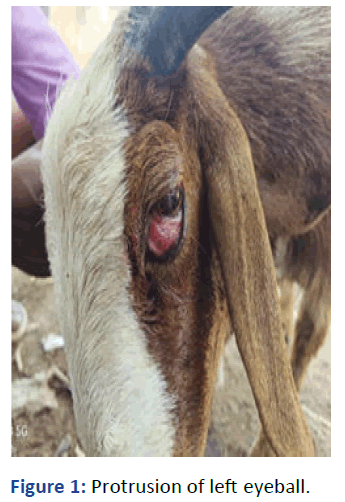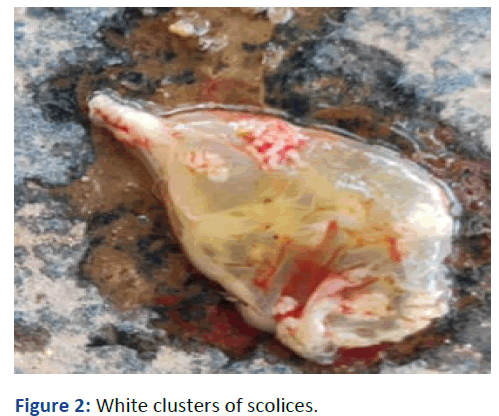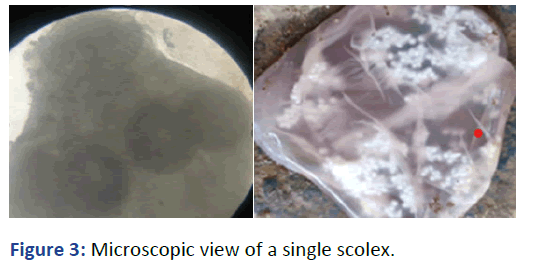Review Article - (2023) Volume 7, Issue 3
Retrobulbar Coenurus Cyst in the Orbit of Nellore Brown Sheep
K Jalajakshi,
LSS Varaprasad Reddy,
M Chandrakala and
P Madhava*
Department of Parasitology, Tamil Nadu Veterinary and Animal Sciences University, Chennai, Tamil Nadu, India
*Correspondence:
P Madhava, Department of Parasitology, Tamil Nadu Veterinary and Animal Sciences University, Chennai, Tamil Nadu,
India,
Tel: 9014751666,
Email:
Received: 08-Jun-2023, Manuscript No. IPJVMS-23-16699;
Editor assigned: 12-Jun-2023, Pre QC No. IPJVMS-23-16699 (PQ);
Reviewed: 26-Jun-2023, QC No. IPJVMS-23-16699;
Revised: 07-Aug-2023, Manuscript No. IPJVMS-23-16699 (R);
Published:
14-Aug-2023, DOI: 10.36648/IPJVMS.7.3.22
Abstract
Adult Nellore brown sheep was presented to veterinary hospital, Peddaputta village of Kadapa district
with a history of swollen unilateral protrusion of left eye ball with congestion of conjunctival mucous
membrane, exophthalmos condition since 6 weeks. Clinical examination revealed blindness due to
chronic keratitis and on palpation found a large fluid filled bladder in the left eye. With the surgical
intervention the cyst was removed successfully along with its membrane from the retrobulbar region
of the left eye and on parasitological examination it was diagnosed as Coenurus gaigeri cyst, (which is
the intermediate stage of T. multiceps gaigeri) and the animal recovered after treatment with
antibiotics and pain killers. Exophthalmos is the bulge of one or the two eyes anteriorly out of the
circle because of an expansion in orbital items inside the unbending hard circle. It most ordinarily
appears in thyroid-related eye sickness, for example, Graves' illness ophthalmopathy. Clinicians should
know about the differential findings that may likewise bring about exophthalmos, as these could be
barely noticeable in patients with disturbed thyroid capability. To reestablish and keep up with ideal
vision, it should be quickly analyzed and treated. This action shows the assessment and the executives
of exophthalmos and features the job of the inter-professional group under the watchful eye
of patients with this condition.
Exophthalmos (otherwise called proptosis) is the projection of one eye or both anteriorly out of the
circle. It gets from Greek, signifying protruding eyes. It happens because of an expansion in orbital
items in the ordinary life systems of the hard circle. Contingent upon the fundamental reason,
exophthalmos might be joined by foundational side effects. Vision might be upset in the event that
the optic nerve is compacted related to the basic etiology of exophthalmos.
The frequency of exophthalmos might change relying on the basic reason. In one sided exophthalmos,
under 33% of patients will have thyrotoxic movement. A lot of reciprocal exophthalmos was generally
a consequence of endocrine irregularities. The mean place of the globe, as estimated utilizing an
exophthalmometer, is 16 mm. There is variety between the genders and between races.
Keywords
Conjunctival; Coenurus gaigeri cyst; Exophthalmometer; T. multiceps gaigeri; Protruding
eyes
Introduction
Coenurus gaigeri is the larval stage of Taenia multiceps gaigeri, which belongs to the class cestoda of the family
Taenidae and genus Multiceps. These parasitic infections
result in asymptomatic focal lesions which often persist
throughout the life span of the host. Coenurosis caused by Coenurus gaigeri is commonly reported in shoulder, thigh,
neck, diaphragm, heart, kidney, uterus, rectum, spleen,
urinary bladder, lumbar region and lower eyelid [1].
Coenurosis is a major parasitic disease in small ruminants
throughout the world. Surgical management of coenurosis in a
goat has been described by Ahmed, et al. [2]. This article
describes the management of retro-bulbar cyst of Coenurus
gaigeri in Nellore brown adult sheep. An exhaustive history
will assist with laying out the basic reason. Side effects, for
example, heat prejudice, weight reduction, change in gut
propensities, and palpitations might uphold a determination
of thyrotoxicosis [3]. There might be a background marked by
injury or sacred side effects, for example, weight reduction
that might propose cystic or tumoral development. The pace
of beginning might give understanding into its etiology. Quick
beginning might propose incendiary illness, dangerous
growths, and carotid-enormous fistula, while steady beginning
suggests to some degree harmless pathology. The presence of
torment may usually show disease (e.g. orbital cellulitis).
Transitory exophthalmos set off by the Valsalva move might
be reliable with orbital varices.
The assessment ought to incorporate an overall assessment of
the patient to distinguish any foundational sickness like
Graves' illness, leukemia, instinctive neoplasm, or protected
signs that might lead to doubt of harm. Clinicians should
embrace a full eye assessment, evaluating a patient's
extraocular developments, visual keenness, field appraisal,
understudy convenience, and reflexes. Intraocular pressures,
foremost fragment, and fundoscopy ought to be performed
[4].
Exophthalmos might be seen on assessment and evaluated
utilizing an exophthalmometer, by which the degree is
estimated by the separation from the corneal pinnacle to the
midpoint of the foremost edge of the circle. It very well might
be joined by other extraocular and foundational signs
pertinent to fundamental causes. The clinician ought to stay
at a similar level as the patient. The white of the sclera is
usually presented poorly to the iris in exophthalmos [5].
A full indicative workup should incorporate a full screen of
blood tests, including total Blood Count (CBC), thyroid
capability and auto-immunizer tests, renal capability, and Creceptive
protein. Nasal swabs and blood societies might be
justified assuming that serious disease is thought. E.g. orbital
cellulitis [6].
Radiological imaging is fundamental for symptomatic and the
board purposes. Figured Tomography (CT) and attractive
reverberation imaging (X-ray) are the highest quality level
modalities in assessing the circle or head for purposes of
serious contamination, mass development, and unfamiliar
bodies connected with exophthalmos. Positron outflow Tomography (PET) permits the appraisal of metastatic illness,
including leukemia, lymphoma, and metastases from optional
malignant growths [7].
As many cases might give covering clinical highlights and may
give trouble in affirming the finding, a tissue biopsy might be
important to discover a conclusive response.
Proptosis or exophthalmos might be related with different
deviations of the globe, specifically, hyperglobus, hypoglobus,
esoglobus, or exoglobus.
Literature Review
General
Treatment of the basic reason is essential for the administration
of exophthalmos to keep up with visual capability [8]. On
account of thyroid-related orbitopathy and other auxiliary
causes, successful administration requires an interprofessional
approach between eye subject matter experts, essential
consideration clinicians and, endocrinologists.
Way of Life Alterations
Smoking suspension is principal in the counteraction and
movement of thyroid eye sickness [9].
Moderate Administration
Strong treatments will give fitting indicative help to patients
while treatment of the basic reason begins. Effective additive
free visual greases and taping eyelids ought to be managed to
patients with dry eyes [10]. Around 66% of gentle cases settle
in no less than a half year, subsequently strong treatment
might do the trick. Shades and defensive eyewear can be
urged to help safeguard against photosensitivity and glare.
Diplopia is reasonable with Fresnel crystal or monocular
impediment. At last, upper eyelid withdrawal might be revised
with botulinum poison infusion straightforwardly into the
levator palpebrae superioris [11].
Clinical Administration
Moderate-to-extreme thyroid orbitopathy is treated with oral
and intravenous corticosteroids. Incendiary and immune
system causes will profit from lessening edema and orbital
blockage. Chemotherapy specialists might be choices to
decrease cancer mass and weight.
Careful Administration
Medical procedure is shown to eliminate the culpable tissue,
cancer, or harmful infection where proper.
Orbital decompression and extraocular muscle fix have
safeguarded vision in extreme instances of exophthalmos for
quite a long time, especially when patients neglect to answer
clinical treatment [12]. The visual capability has allegedly
worked on by up to 82% of cases.
Differential Conclusion
Immune system, provocative circumstances, injury, and
neoplastic sickness are the most widely recognized
differentials that should justify thought in the differential
finding. These incorporate thyroid related orbitopathy
connected with Graves sickness; irresistible circumstances, for
example, orbital and preseptal cellulitis; vascular distortions
including carotid-enormous fistula; harmless and threatening
growths including danger including fine haemangioma,
neuroblastoma, leukemia, lymphoma, mucocele, pseudo
tumors, and auxiliary metastatic cancers that might bring
about metastatic stores in the circle. Other uncommon
differentials might incorporate Crouzon condition and Apert
disorder. Periorbital breaks because of injury might result in
periorbital discharge that might possibly jut the globe [13].
Visualization: Early recognition of the hidden reason for
exophthalmos is essential for goal. Any related expanding,
agony, or erythema will be regularly self-restricting following 2
to 90 days, albeit this might shift from one patient to another.
Thyroid related exophthalmos might take significantly longer,
or may not get back to business as usual, with up to 5% of
cases holding super durable diplopia, and declining or
supporting long lasting visual disability.
Difficulties: These ordinarily are connected with the
fundamental sickness. Delayed openness of the cornea might
bring about optional openness keratopathy assuming that the
cornea turns out to be exceptionally dry, especially around
evening time, on the off chance that there is inadequate
eyelid conclusion. This condition might prompt chemosis and
conjunctivitis. Corneal ulceration and keratitis might follow
as additional intricacies. Extremely durable visual
aggravation, for example, diplopia is intriguing assuming
that the hidden etiology gets treatment early and
quickly [14]. Other interesting intricacies have additionally
included predominant limbic keratoconjunctivitis and optic
decay.
Discouragement and patient instruction: Patients ought to
know that normal checking and strong techniques for their
exophthalmos will give suggestive help, notwithstanding the
clinical or careful administration of the fundamental reason
[15]. Accordingly, ordinary grease of the eyes, observing, and
commitment with the treatment plan set by the
ophthalmologist, essential consideration clinician, and
emergency clinic care clinician will guarantee that patients are
fittingly treated.
Improving Medical Services Group Results
An interprofessional group approach between eye trained
professionals, essential consideration clinicians, and
endocrinologists, if thyroid-related, is fundamental in planning
the best results for patients with exophthalmos. Customary
checking of visual capability is vital for guess [16]. Shared
dynamic in the administration arranging of a patient's
consideration furnishes greatest advantage in accordance with
the patient's thoughts, concerns, and assumptions. Synergistic
cooperation with the patient on their wellbeing will prompt
better results [17].
Graves' infection makes the thyroid organ overproduce
thyroid chemicals. The treatment is moderately
straightforward, yet without it, the sickness can make serious
impacts. Graves' infection is an immune system condition
[18]. This implies the body's resistant framework botches
solid cells for unfamiliar obtrusive bodies and goes after
them. Graves' infection causes an overactive thyroid, an issue
likewise called hyperthyroidism. The thyroid is a little organ in
the neck that produces thyroid chemicals, which control how
the body utilizes energy. Graves' infection makes the resistant
framework assault the thyroid, creating overabundance
thyroid chemical [19]. A few circumstances can cause
hyperthyroidism, yet Graves' sickness is the most well-known
cause in the US, influencing around 1 in 200 trusted source
individuals. The sickness is more normal among females and
individuals between the ages of 30 and 50. Graves' sickness
takes its name from Sir Robert Graves, an Irish specialist who
initially depicted the condition close to a long time back.
Discussion
Adult Nellore brown sheep was presented to veterinary
dispensary Peddaputta of Kadapa district with the history of
unilateral protrusion of left eyeball, blepharitis, and
congestion of conjunctival mucus membrane (Figure 1).
Physical examination of left eye region revealed presence of a
large fluctuating fluid filled bladder with distinct dimensions.
With the surgical intervention the cyst was removed. The cyst
contained huge number of white clusters of scolices (Figure
2). The fresh and unstained scolices of the cyst were
examined under microscope after applying sufficient coverslip
pressure to force the hooks to lie flat. Microscopic view of
a single scolex revealed the characteristic rose thorn taenid
hooks (Figure 3).

Figure 1: Protrusion of left eyeball.

Figure 2: White clusters of scolices.

Figure 3: Microscopic view of a single scolex.
Ceftriaxone (Monocef) @10mg/kg. b. wt. and Meloxicam
@0.2 mg/kg. b. wt. were administered intravenously for
3 days post operatively and local antiseptic dressing for
surgical wound with dilute liquid povidone was done for 7
days. The animal recovered in ten days. Coenurosis has
emerged as a major parasitic disease of zoonotic importance
in developing nations due to inadequate measures for proper
disposal of contaminated carcasses. Chronic parasitic
infections are more commonly seen in adult animals and
these animals are the source of infection for other animals
and human beings. Sheep and goats are the usual
intermediate host of Taenia multiceps but other domestic)
and wild herbivores, human and non-human primates can
also be infected. Control measures like feeding of sheep
and goat carcasses and offal’s to the dogs should be
restricted and regulated and proper hygienic disposal of
carcass and offal’s should be carried out by incineration and
deep burying. The intermediate hosts
(sheep and goat) get the infection from the stool of the final
host canids. Therefore, the entry of stray dogs or wild
canids should be prohibited into the animal farms and
pastures. The dogs in and around the animal farms should
be treated with anti-helmintics to prevent the spread of
infection to the farm animals. The shepherd dogs kept with
the sheep and goat herds must be regularly treated for the
control of mature tape worms. Prophylactic anthelminthic
therapy can be given to the small ruminants, but the
economic feasibility must also be considered. Coenurus
cerebralis cysts are often localised in the nervous system
including brain and spinal cord. However, their occurrence in
the sub cutaneous and muscular tissues and other organs
has also been recorded in goats. As the function of the vital organs is affected in non-cerebral form of coenurosis, it
often results in stunted growth and wasting in small ruminants.
Conclusion
The present study described a case of retrobulbar coenurosis
in Nellore brown sheep. Taenia multiceps coenurus most likely
lodges in the eyes of domestic animals as ruminants acts as
intermediate hosts for this T. multiceps gigeri. So,
surgical removal of the cyst followed by treatment with
antibiotics and following effective control measures like
hygienic disposal of offals, public awareness about the
disease, usage of prophylactic anti-parasitic drugs and
deworming of stray dogs will be more useful in endemic areas.
References
- Ahmed JU, Haque MA (1975) Surgical treatment of coenuriasis of goats. Bangladesh Vet J. 9:31-34.
- Bhatia BB, Pathak KML, Juyal PD (2010) Text book of veterinary parasitology. 24(2):211.
- Biswas D (2013) Ultrasound diagnosis and surgical treatment of coenurosis (gid) in Bengal goat (Capra hircus) at Chittagong metropolitan area, Chittagong, Bangladesh. Sci J Vet Adv. 2:68-75.
[Google Scholar]
- Gahlot TK, Purohit S (2005) Surgical management of gid (coenurosis) in goat: Case report. Intas Poly vet. 6:297-298.
- Haridy M, Sakai H, El-Nahass ES, El-Morsey A, Anwar S, et al. (2013) Coenurus cerebralis cysts in the left lateral cerebral ventricle of a ewe. J Vet Med Sci. 75:1643-1646.
[Crossref] [Google Scholar] [PubMed]
- Ing MB, Schantz PM, Turner JA (1998) Human coenurosis in North America: Case reports and review. Clin Infect Dis. 27:519-523.
[Crossref] [Google Scholar] [PubMed]
- Jones A, Pybus M J (2008) Parasitic diseases of wild mammals. 2nd edition. Iowa State University Press, Ames. 150-192.
[Google Scholar]
- Kheirandish R, Sami M, Azizi S, Mirzae M (2012) Prevalence, predilection sites and pathological findings of Taenia multiceps coenuri in slaughtered goats from South-East Iran. Onderstepoort J Vet Res. 79:1-5.
[Crossref] [Google Scholar] [PubMed]
- Madhu DN, Mahan T, Sudhakar NR, Maurya PS, Banerjee PS, et al. (2014) Coenurus gaigeri cyst in the thigh of a goat and its successful management. J Parasit Dis. 38(3):286-288.
[Crossref] [Google Scholar] [PubMed]
- Nandi SK, Pal A (2001) Successful surgical management of cyst in goat: A case report. Indian J Anim Health. 40:83-84.
- Oge H, Oge S, Gonenc B, Ozbakis G, Asti C (2012) Coenurosis in the lumbar region of a goat: A case report. Vet Med-Czech. 57:308-313.
[Google Scholar]
- Oryan A, Nazifi S, Sharifiyazdi H, Ahmadnia S (2010) Pathological, molecular, and biochemical characterization of Coenurus gaigeri in Iranian native goats. J Parasitol. 96:961-967.
[Crossref] [Google Scholar] [PubMed]
- Ozkan C, Yildirim S, Kays A (2011) Clinical coenurosis (Coenurus cerebralis) and associated pathological findings in a calf. Pakistan Vet J. 31:263-266.
[Google Scholar]
- Raidurg R, Reddy, PMT (2009) Parasitic cyst (Coenurus gaigeri) in the lower eyelid of a kid-a case report. Intas Polivet. 10:302-303.
[Google Scholar]
- Ramadan RO, Magzoub M, Adam SEI (1973) Clinico pathological effects in a Sudanese goat following massive natural infection with Coenurus gaigeri cysts. Trop Anim Health Prod. 5:196-199.
[Crossref] [Google Scholar] [PubMed]
- Sadarnashipur PO, Lalgola PS (1991) Prevalence of Coenurus of multiceps gaigeri in goat and its predilection site distribution. Indian J Comp Microbiol Immunol Infect Dis. 12:71-72.
- Sharma DK, Chauhan PPS (2006) Coenurosis status in Afro-Asian region: A review. Small Rumin Res. 64:197-202 .
[Google Scholar]
- Soulsby EJL (1982) Helminths, arthropod and protozoa of domesticated animals. London, 7th edition, UK. 35-740.
[Google Scholar]
- Wills J (2001) Coenurosis in a pet rabbit. Vet Res 148:188.
[Google Scholar] [PubMed]
Citation: Jalajakshi K, Varaprasad Reddy LSS, Chandrakala M, Madhava P (2023) Retrobulbar coenurus cyst in the orbit of
Nellore brown sheep. J Veterinary Med. 7:22.
Copyright: © 2023 Jalajakshi K, et al., et al. This is an open-access article distributed under the terms of the Creative Commons
Attribution License, which permits unrestricted use, distribution, and reproduction in any medium, provided the original author
and source are credited.




